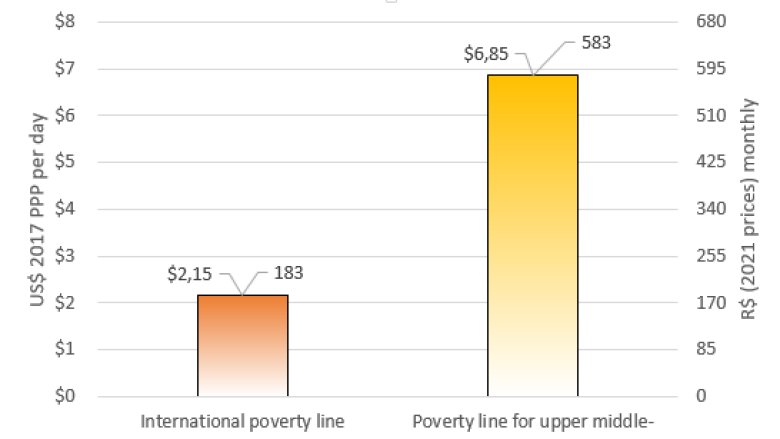The World Bank’s new poverty lines help understand the situation of the most vulnerable and guide public policy
Pablo Acosta
Folha de S. Paulo
As the COVID-19 pandemic began to ease its effects on households across the globe, another crisis started searing: inflation. The costs of food and fuel began rising as early as the second half of 2021 in many countries in the world. By mid-2022, annual inflation was estimated at 9.8 in Europe, 8.5 in the US, and 13.9 in Brazil. Inflation for the LAC region for 2022 is forecasted at 12.1.
Hiking prices lead to loss of purchasing power of households and food insecurity. In Brazil, the costs of food increased by 13.43 percent in the 12 months to August 2022, and the foodstuff consumed at home by 15.63 percent. The effects on such items – which represent between a fifth and a quarter of household’s consumption- were only partly appeased by the increase in nominal average labor incomes in 2022. Thus, food insecurity is estimated to have gone up in 2022, with a projected 15.5 % of households in severe food insecurity, compared to the 9 percent in 2020.
It is against this backdrop that we arrive at another International Day for the Eradication of Poverty, also commonly known as End Poverty Day (October 17th). As the real value of households’ income deteriorates, they can afford to purchase fewer things. Ultimately, the accurate monitoring of countries’ progress towards eradicating poverty rests on our ability to measure whether the population can cover their basic needs.
Reflecting properly the costs of basic needs is key to track and monitor poverty
For a long time, part of the World Bank’s mandate has been to develop knowledge that can inform policy making fostering inclusive and sustainable growth. It is partly due to this fact that the World Bank became the custodian of the indicator of extreme poverty – the measure to monitor Target 1.1 of the Sustainable Development Goal 1 of ending poverty in all its forms everywhere.
Last month, the World Bank published an update to the indicator that is used to track extreme poverty, as well as the poverty lines that it uses to monitor monetary deprivation in countries with higher levels of development. The update was done for two main reasons.
First, due to the availability of price information available for the year 2017 for a broad range of countries – collectively called the International Comparison Program (ICP) – resulting in the publication of the 2017 Purchasing Power Parity (PPP) factors. These factors allow the international comparison of the value of a basket of goods across countries. By incorporating the country-specific costs of living, they offer an improvement from using exchange rates only. The 2017 PPP also incorporated improvements in the quality of price data.
Second, the new release improves upon the methodology used to calculate the poverty lines. The new methodology has several advantages, including the use of poverty lines calculated by national statistics institutes of each of about 30 low-income countries as the main reference to calculate extreme poverty. This approach relies on the most accurate reflection of economic deprivation as captured by the local context in these countries.
While it would be tempting to suggest that a revision of the poverty lines may shift the goalposts of extreme poverty (for instance as expressed by the Atkinson Commission on Global Poverty), a thorough review was conducted and found very small changes with respect to the previous poverty lines.
What does this mean for Brazil?
Between 2011 and 2017, the period between the two PPP calculations, many countries have seen their costs of living increase. The values of the recently published 2017 PPP poverty lines aim to reflect this phenomenon. The international poverty line used to measure extreme poverty is $2.15 per person per day, while the poverty line for upper middle-income countries is $6.85. These lines are equivalent to R$6.01 (in 2021 prices) per person per day and to R$19.16 (in 2021 prices) per person per day, respectively.
The new lines give us better insights on the situation of the vulnerable. While extreme poverty temporarily dropped to 1.9 percent in 2020 – putting Brazil’s poverty among the lowest in the Latin America and the Caribbean region- it is estimated to have bounced back to 5.8 percent in 2021. In turn, the upper middle-income threshold suggests that, using the updated purchase power parity estimates, 18.7 percent of the population were living with less than $6.85 2017 PPP in 2020. While a large share of the population was protected during the pandemic, the new line suggests that about 11.8 million more people could not afford their basic needs. Moreover, the slow labor market and the elimination of Auxilio Emergencial may have contributed to the increase to 28.4 percent the following year. But, does the $6.85 line actually reflects monetary poverty? In fact, the international line of $6.85 may better capture the poor and vulnerable in Brazil. This line is roughly equivalent to R$583 per person per month, just slightly above R$550 – the income threshold that households need to meet to be registered in the Cadastro Unico, the nation’s social registry, and be considered for public assistance.
A final note is worth making. Global poverty lines are used primarily to track global extreme poverty and to measure progress on global goals set by the World Bank, the United Nations, and other development partners. Nonetheless, a country’s national poverty line is still the most appropriate tool to inform policy dialogue or targeting programs to reach the poorest. As Brazil currently does not have an official poverty line, the current inflationary pressure on households’ welfare may be a good reason to jumpstart a dialogue about the importance of defining one.
____________________________
This article was written in collaboration with Gabriel Lara Ibarra, World Bank senior economist.

